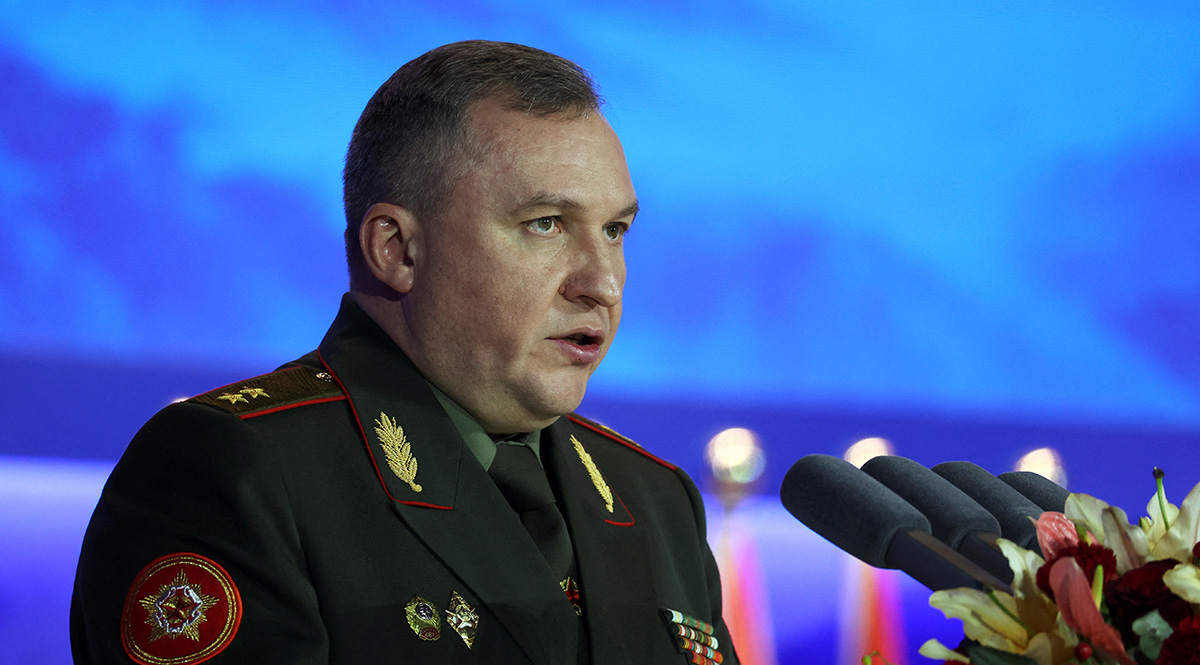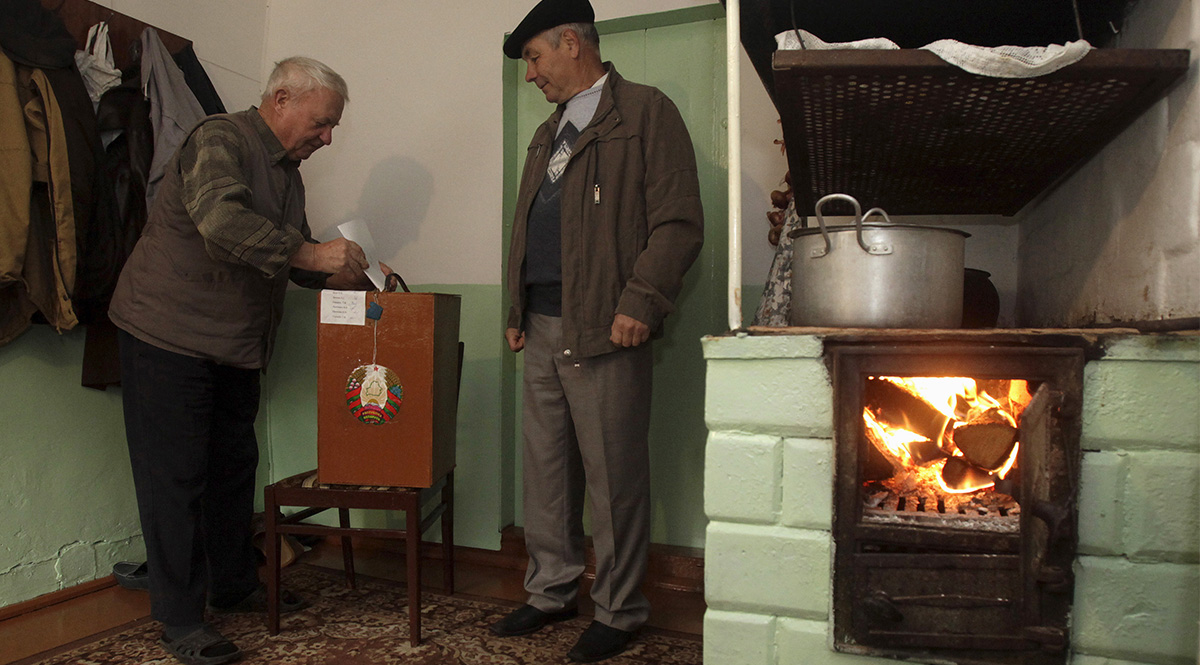Belarus Updated Security Strategies Identify Threats from the West
Belarus has released the latest unclassified versions of its war doctrine and national security concept, which, according to the country’s authorities, are in response to changing threats. The contents of both documents confirm the anti-Poland and anti-Western policy of the Belarusian authorities. For Poland and NATO, this means that the entire spectrum of threats coming from Belarus must be weighed in the context of escalation scenarios from Russia against NATO.
 FLORENCE LO / Reuters / Forum
FLORENCE LO / Reuters / Forum
On 25 April, the All-Belarusian People’s Assembly unanimously adopted the National Security Concept and War Doctrine developed by a national group of experts from, among others, the Ministry of Defence and the Belarusian Security Council. According to Defence Minister Viktar Khrenin, both documents were created in response to the conflict in Ukraine and “revisionist U.S. policy”. The vote was preceded by an anti-Poland and anti-Western speech by Alexander Lukashenka, and the adopted documents clearly identify the policies of NATO countries as the main source of threats.
Changes to the National Security Concept
The NSC is the most important document identifying the sources of threats to the Belarusian state, containing framework plans for preventing and countering them. The document has the same structure and length as the 2010 version, but the new one includes a number of references to the current security situation in Europe, including the war in Ukraine and the effects of the COVID-19 pandemic. Among the most important dangers its authors identified were attempts to interfere in the independence and internal affairs of the state, extremism, and the imposition of sanctions by other states. Pandemics, threats to the functioning of critical infrastructure, hostile actions in cyberspace and the spread of “Nazi” ideology were also mentioned as significant security challenges.
Other threats mentioned were attempts to interfere from outside in the internal situation of Belarus after the 2020 presidential elections, including the activities of Belarusian independence organisations in exile, such as BYPOL (which brings together former officers, soldiers and officers who left Belarus for political reasons) or the Kalinoŭski Regiment fighting on the side of Ukraine. Some of the dangers, such as those related to the policies of Western countries or the promotion of “Nazism”, correspond to the security threat catalogue identified by Russia, which is also a change compared to the 2010 version.
New War Doctrine
The adoption of the new war doctrine, as well as the concept of national security, was justified by the Belarusian authorities on the basis of the changing security situation in Europe, the alleged aggressive and revisionist policy of Western states and armed actions in Ukraine. The new document is twice as long as the previous one, has a revised structure, points to a different nature of threats, and focuses on the organisation of the state for times of war and the preparation of citizens for it. It is also much more confrontational in nature than the 2016 war doctrine. The previous one was a reflection of the situation in 2014 and thus the illegal annexation of Crimea by Russia and armed actions in the Donbas with, among other things, the use of unmarked armed formations. At the time, Belarus indicated that it could be threatened by the actions of groups of this type, which suggested that it was distancing itself from Russian aggression and reckoning with hostile actions from Russia. In the current version, Belarus identifies as the most significant threat the policies of NATO members, including Poland, which, along with the U.S. and the Baltic States, is indicated several times. The authors of the document, however, mention the deployment of Russian tactical nuclear weapons on Belarusian territory as an important deterrent.
For the first time in a document of this kind, there was a provision stating that Belarus allows participation in an international armed conflict outside its borders within the framework of allied activities. For many years, the Belarusian authorities did not allow the use of its army outside, except for occasional participation in peacekeeping missions under the UN, among others, and the first significant change in this policy was the participation of Belarusian soldiers in the CSTO operation in Kazakhstan in 2022. This change shows the abandonment of one of the important elements of the unwritten social contract concluded between Lukashenka and Belarusians back in the 1990s in favour of the fulfilment of alliance commitments towards Russia and, to a lesser extent, towards other CSTO partners. This provision, together with the assessment of threats and possible responses to them, shows the almost complete subordination of Belarusian security policy to Russia’s objectives.
Consequences of the Adoption of the New Documents
The provisions of both documents will translate into a further deepening of the military integration of Belarus and Russia. Both the security concept and the war doctrine emphasise the importance of the Belarusian-Russian alliance within the Union State for the defence of Belarus. Compared to the war doctrine, the security concept is not as explicitly anti-Western in character, but its message is the same and the two documents are complementary in terms of the indicated catalogue of major threats. Both documents take into account the recent changes in the Belarusian constitution, including the transformation of the All-Belarusian People’s Assembly into one of the most important bodies of the state and one that has significant impact on defence planning and defence of the country. The updates also clearly specify the tasks for the most important state institutions in times of crisis and war, putting the president and his administration and the All-Belarusian People’s Assembly, which he controls, in the forefront, and other structures in the background.
The documents sanction Belarus’ move away from the pursuit of neutrality and non-nuclear status. They show that, in strengthening its defence capabilities, Belarus will focus on ensuring information security for its troops, the development of territorial defence troops, national self-defence forces, and the militarisation of Belarusian society. Belarus will also focus on arms production, procurement, and the development of command and control systems, electronic reconnaissance, drones, missile technology, artillery and armoured systems, and shooting weapons. These plans are an outgrowth of the lessons of the war in Ukraine, but are also compatible with declarations by the Russian authorities regarding the further development of its armed forces. The consequence will also be the continuation by the Belarusian authorities of a policy hostile to the West, including Poland. This will be manifested by, among others, Belarus in its conduct, in cooperation, and coordination with Russia of hybrid actions against Poland and other countries on NATO’s Eastern Flank.
Conclusions and Recommendations
The anti-Western nature of the national security concept and war doctrine is the result of a change in the policy of the Belarusian authorities after the rigged presidential elections in 2020. Belarus has defined the U.S., Poland, and the Baltic states, which actively support independent circles, as the most important sources of threats. It is also the result of political, economic, and military integration with Russia and the subordination of its foreign and defence policy interests to that country since 2020. Changes to both documents are also a result of the entry into force of amendments to the Belarusian constitution.
The provisions of both documents indicate plans for further military integration with Russia and expanding cooperation with CSTO members. As part of its planned international outreach activities, Belarus is likely to more actively support Russia’s approach to the war in Ukraine and the construction of a new European security architecture. This means that it will promote Russian proposals for so-called indivisibility of security and arms control, which will seek to limit the ability of NATO states to carry out collective defence missions and thus increase the ability of Russia and Belarus to influence their threat perception. Belarus will also oppose the enlargement of the Alliance.
Given the confrontational nature of the new war doctrine vis-à-vis NATO states, Poland, all Alliance countries should treat Belarus as an unfriendly state pursuing Russian interests and part of the Russian military space and take this into account in defence planning, but also in concepts related to actions, for example, in cyberspace. At the same time, it is in the interest of Poland and other Western countries to support exiled independent circles, in particular the one centred on the cabinet of Sviatlana Tsikhanouskaya. These circles unequivocally dissociate themselves from the policy of the Belarusian authorities, demand the withdrawal of Russian nuclear weapons from Belarus, and have already entered into dialogue with NATO, pointing to the necessary future cooperation of a democratic Belarus with the Alliance.



.jpg)
.jpg)
